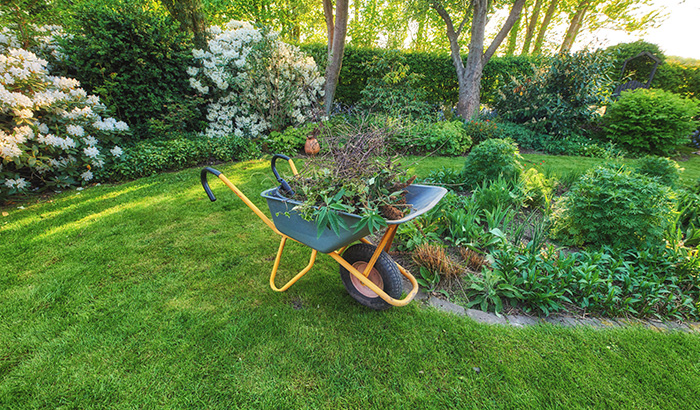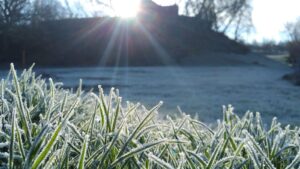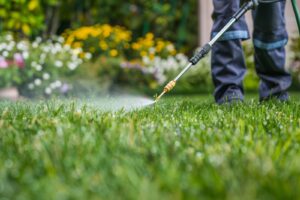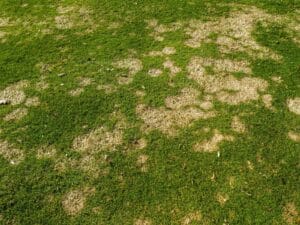Utah’s diverse landscapes and distinct seasonal changes present unique challenges and opportunities for lawn care enthusiasts. From the high desert’s arid stretches to the mountainous regions’ snowy peaks, each area demands a tailored approach to maintain a lush, healthy lawn.
As the seasons change, so do the needs of your grass, requiring a keen understanding and a proactive approach to lawn maintenance.
In this comprehensive lawn care guide, we’ll explore the best practices for seasonal lawn care adapted to Utah’s varied climate zones. Get ready to arm yourself with the right knowledge and tips to ensure your lawn stays vibrant and healthy all year round.
Spring Lawn Care
Spring in Utah brings a crucial period for seasonal lawn care, with each climate zone requiring specific strategies to wake up lawns from winter dormancy and prepare them for the growing season.
High Desert Region
In the High Desert, spring is a time to rejuvenate lawns after cold winters. It’s a good idea to start by aerating, as this alleviates soil compaction and allows moisture and nutrients to penetrate deeply. Apply a balanced, slow-release fertilizer to nourish the grass. Given the region’s aridity, initiate a regular watering schedule to give your lawn the hydration it needs.
Mountainous Region
The cooler, mountainous areas require more patience. It’s important to wait until the snow melts and the soil dries out a bit before starting.
Aerate the compacted soil to revive grass roots and follow up with light fertilization. Overseed bare patches with cool-season, higher-altitude grass varieties. Wait to start watering until the temperatures consistently warm up, as early watering in colder soils won’t be as effective.
Transition Zone
In Utah’s Transition Zone, adaptability is key. Start by assessing the lawn’s condition as spring temperatures stabilize. Aerating is essential here to help both warm and cool-season grasses recover.
Apply a moderate-rate fertilizer that’s suitable for a mixture of grass types. Watch out for early weed growth and treat weeds accordingly. Gradually increase your watering frequency with varying temperature swings in mind.
Southern Utah Region
In the warmer southern regions, spring lawn care focuses on preparing for the heat.
Begin with a thorough dethatching to remove winter debris and allow the soil to breathe. Fertilize early to give the grass a head start before the intense summer heat sets in. Start a consistent watering routine, and consider applying a pre-emergent herbicide to prevent common warm-season weeds.
Spring is also an ideal time for all zones to sharpen mower blades and ensure all lawn care equipment is in good working condition. Tailoring your approach to your specific climate zone in Utah will ensure your lawn is healthy, resilient, and ready for the warmer months ahead.

Summer Lawn Care
During the summer months, you’ll want to focus on managing the heat and ensuring your lawn stays healthy.
High Desert Region
In the High Desert, coping with heat and limited water is critical. Raise your mower blades to leave grass taller, as longer blades shade the soil and retain moisture. Water deeply but not super often to encourage deep root growth, usually early in the morning, to minimize evaporation.
Monitor for signs of drought stress and adjust your watering schedule accordingly. Use a slow-release fertilizer early in the summer to support growth without overstimulating the grass during peak heat.
Mountainous Region
Summer in the mountainous areas is relatively short and mild. Maintain a moderate grass height and water consistently, especially during dry spells. Given the cooler climate, it’s okay to fertilize in early and late summer to keep your lawn robust. Be vigilant about pest and disease control, as the cooler, moist conditions promote their growth.
Transition Zone
Balancing the needs of cool and warm-season grasses is essential. It’s important to just adjust your mowing heights as temperatures rise, keeping grass slightly longer to protect against heat stress.
Water deeply enough to penetrate the root zone, typically once or twice a week. This is somewhat dependent on whether there’s rainfall. Apply a light summer fertilizer if needed, but be cautious not to over-fertilize, as it can stress the grass.
Southern Utah Region
In Southern Utah, where temperatures soar, water management is crucial. Water early in the morning and aim for deeper, less frequent watering to encourage drought resistance.
Taller grass heights help protect roots from extreme heat, so adjust your mowing accordingly. Minimize fertilizing during the peak heat to prevent burning the grass. Keep an eye out for heat stress and pests, which are common in these warmer conditions.
Regardless of the zone, it’s important to regularly check the health of your lawn, looking for signs of stress or disease. Adjust your care routine as needed to ensure your lawn stays healthy and lush throughout the challenging summer months in Utah.
Fall Lawn Care
Preparing your lawn for the colder months becomes a priority as autumn arrives in Utah.
High Desert Region
In the High Desert, focus on moisture retention and soil health. Begin by aerating the soil to improve water penetration and reduce compaction. Overseed bare spots of grass to ensure your lawn is dense enough to get through winter.
Apply a winterizing fertilizer so your grass gets the nutrients it needs. As it gets colder, don’t water as much, but make sure your lawn still gets enough moisture with how dry it gets.
Mountainous Region
Prepare your lawn for early snowfalls and a harsher winter. Aerate and apply a high phosphorus fertilizer to promote root growth.
Overseeding is beneficial, especially with cool-season grasses that thrive in lower temperatures. Gradually reduce how much you water as the weather cools, but don’t let the soil become too dry before the frost sets in. Clear leaves as they fall to prevent mold and disease.
Transition Zone
Handling both warm and cool-season grasses is key. Aeration and overseeding in early fall help rejuvenate the lawn.
Apply a balanced fertilizer to support the grass in colder months. Adjust the watering schedule to accommodate cooler temperatures and reduced evaporation rates. This is also a good time to treat any persistent weeds, preparing for a cleaner spring growth.
Southern Utah Region
In Southern Utah, with its milder winters, fall lawn care is about maintaining health through the cooler months.
Fertilize with a formula suited for winter preparation, and continue to water the lawn, but reduce the frequency as the weather cools. Overseeding will help improve the lawn’s density, especially where summer heat can wear down an area.
For all zones, it’s important to keep mowing the lawn until it stops growing. Clean and maintain your lawn equipment before storing it for the winter. Properly preparing your lawn in the fall will lead to a healthier, more vibrant lawn once spring arrives.
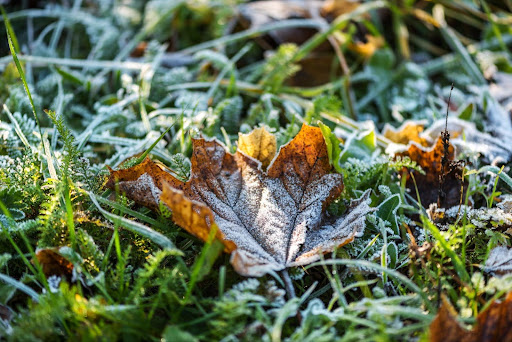
Winter Lawn Care
Winter lawn care in Utah varies significantly across its diverse climate zones, focusing mainly on protection and preparation for the spring.
High Desert Region
In the High Desert, where winters can be cold but dry, the main goal is to protect your lawn from dehydration and temperature fluctuations. It’s a good idea to minimize foot traffic on frozen grass to prevent damage.
If the winter is particularly dry, water the lawn occasionally during warm spells to prevent desiccation. Snow mold is sometimes an issue, so gently remove heavy snow from the grass where possible, especially in shaded areas.
Mountainous Region
The Mountainous areas experience heavy snowfall and colder temperatures. Here, the focus is on managing snow and preventing damage.
Be careful when you use de-ice salts near the lawn since they can harm grass and soil health. Keep snow piles evenly distributed to avoid prolonged snow cover in one area, which can lead to suffocation or snow mold.
Transition Zone
In this zone, with its mix of warm and cool-season grasses, winter care involves balancing moisture levels and protecting against frost. Water the lawn during prolonged dry spells, but avoid overwatering.
Protect vulnerable areas of your lawn with mulch or burlap covers if extremely cold temperatures are forecasted. Check for signs of disease or rodent activity, which can be more pronounced in this varied climate.
Southern Utah Region
Southern Utah’s mild winters require less intensive lawn care. This region is ideal for planning spring lawn activities and repairing any lawn care tools. Keep an eye out for weed growth during warmer winter days and treat them as necessary.
For all regions, avoiding heavy lawn maintenance during the winter is crucial. Let the grass rest and recover, and focus on gentle care and observation. Preparing your lawn correctly in the fall and managing it gently during the winter will pay off with robust growth and health in the spring.
Year-Round Utah Lawn Care With Summit Lawn & Pest Control
At Summit Lawn & Pest Control, we understand the intricacies of Utah’s seasonal lawn care and have the expertise to help your lawn thrive through every season. That’s why we’ve provided you with this lawn care guide.
Don’t let the changing seasons overwhelm you. Contact Summit Lawn & Pest Control today, and let us take the guesswork out of your lawn care routine. With our help, you can enjoy a vibrant, healthy lawn that’s the envy of the neighborhood all year round. Reach out to us now — your lawn will thank you!


